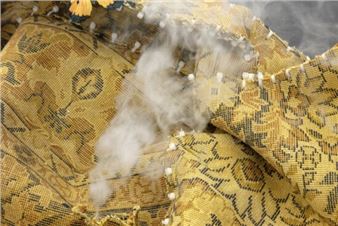Janek Simon: The Sea
"Morze" [The Sea] is a summa of Janek Simon's overseas experiences. Having for many years travelled across Asia, Africa, or the Caribbean, the artist not only followed the traces of colonialism but also analysed the changes in his own consciousness - from excitement to disappointment with the notorious and ubiquitous aura of exoticism accompanying all travel. By exploring the political and economic mechanisms of colonial conquests Simon verifies the standards of "political correctness" of today. "Morze" [The Sea] is a lesson in geography in its final stage - a sketch of a new atlas which no longer is based on physical distances but distances in culture, economy, civilization, and communication. "Morze" [The Sea] is also a title of a monthly issued in the 1930's by Maritime and Colonial League, a rostrum of Polish imperialistic aspirations, a synonym of our national struggles with identity and place in the world.
The Raster exhibition is composed of two groups of works. The first one is made up of objects and films which touch on the artist's personal experiences of a tourist and explorer. "The way to the port in Tamatave" (2006) or "A guided tour of Fort Amsterdam" (2010) are films documenting Simon's two travels: to Madagascar and to Ghana. The camera lens unmasks the everyday reality of a travel, stripping it from all exotic charm. Most importantly, however, it reveals the relevance of ethical dilemmas of travelling. By filming a mumbling guide in a historic harbour - once a point of collection of slaves - or a rickshaw man, Simon shows how the quotidian economy of the post-colonial world brutally verifies the vision of an innocent exotic journey, and how tourism helps the stereotypical relations between the "visitors" and "locals" remain intact.

"Morze" [The Sea] is a summa of Janek Simon's overseas experiences. Having for many years travelled across Asia, Africa, or the Caribbean, the artist not only followed the traces of colonialism but also analysed the changes in his own consciousness - from excitement to disappointment with the notorious and ubiquitous aura of exoticism accompanying all travel. By exploring the political and economic mechanisms of colonial conquests Simon verifies the standards of "political correctness" of today. "Morze" [The Sea] is a lesson in geography in its final stage - a sketch of a new atlas which no longer is based on physical distances but distances in culture, economy, civilization, and communication. "Morze" [The Sea] is also a title of a monthly issued in the 1930's by Maritime and Colonial League, a rostrum of Polish imperialistic aspirations, a synonym of our national struggles with identity and place in the world.
The Raster exhibition is composed of two groups of works. The first one is made up of objects and films which touch on the artist's personal experiences of a tourist and explorer. "The way to the port in Tamatave" (2006) or "A guided tour of Fort Amsterdam" (2010) are films documenting Simon's two travels: to Madagascar and to Ghana. The camera lens unmasks the everyday reality of a travel, stripping it from all exotic charm. Most importantly, however, it reveals the relevance of ethical dilemmas of travelling. By filming a mumbling guide in a historic harbour - once a point of collection of slaves - or a rickshaw man, Simon shows how the quotidian economy of the post-colonial world brutally verifies the vision of an innocent exotic journey, and how tourism helps the stereotypical relations between the "visitors" and "locals" remain intact.

 ARTISTS
ARTISTS











